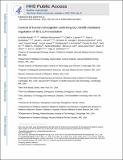Control of human hemoglobin switching by LIN28B-mediated regulation of BCL11A translation
Author(s)
Basak, Anindita; Munschauer, Mathias; Lareau, Caleb A.; Montbleau, Kara E.; Ulirsch, Jacob C.; Hartigan, Christina R.; Schenone, Monica; Lian, John; Wang, Yaomei; Huang, Yumin; Wu, Xianfang; Gehrke, Lee; Rice, Charles M.; An, Xiuli; Christou, Helen A.; Mohandas, Narla; Carr, Steven A.; Chen, Jane-Jane; Orkin, Stuart H.; Lander, Eric Steven; Sankaran, Vijay G.; ... Show more Show less
DownloadAccepted version (3.209Mb)
Open Access Policy
Open Access Policy
Creative Commons Attribution-Noncommercial-Share Alike
Terms of use
Metadata
Show full item recordAbstract
Increased production of fetal hemoglobin (HbF) can ameliorate the severity of sickle cell disease and β-thalassemia1. BCL11A represses the genes encoding HbF and regulates human hemoglobin switching through variation in its expression during development2–7. However, the mechanisms underlying the developmental expression of BCL11A remain mysterious. Here we show that BCL11A is regulated at the level of messenger RNA (mRNA) translation during human hematopoietic development. Despite decreased BCL11A protein synthesis earlier in development, BCL11A mRNA continues to be associated with ribosomes. Through unbiased genomic and proteomic analyses, we demonstrate that the RNA-binding protein LIN28B, which is developmentally expressed in a pattern reciprocal to that of BCL11A, directly interacts with ribosomes and BCL11A mRNA. Furthermore, we show that BCL11A mRNA translation is suppressed by LIN28B through direct interactions, independently of its role in regulating let-7 microRNAs, and that BCL11A is the major target of LIN28B-mediated HbF induction. Our results reveal a previously unappreciated mechanism underlying human hemoglobin switching that illuminates new therapeutic opportunities.
Date issued
2020-01Department
Massachusetts Institute of Technology. Department of Biology; Massachusetts Institute of Technology. Institute for Medical Engineering & ScienceJournal
Nature Genetics
Publisher
Springer Science and Business Media LLC
Citation
Basak, Anindita et al. "Control of human hemoglobin switching by LIN28B-mediated regulation of BCL11A translation." Nature Genetics 52, 2 (January 2020): 138–145 © 2020 The Author(s)
Version: Author's final manuscript
ISSN
1061-4036
1546-1718